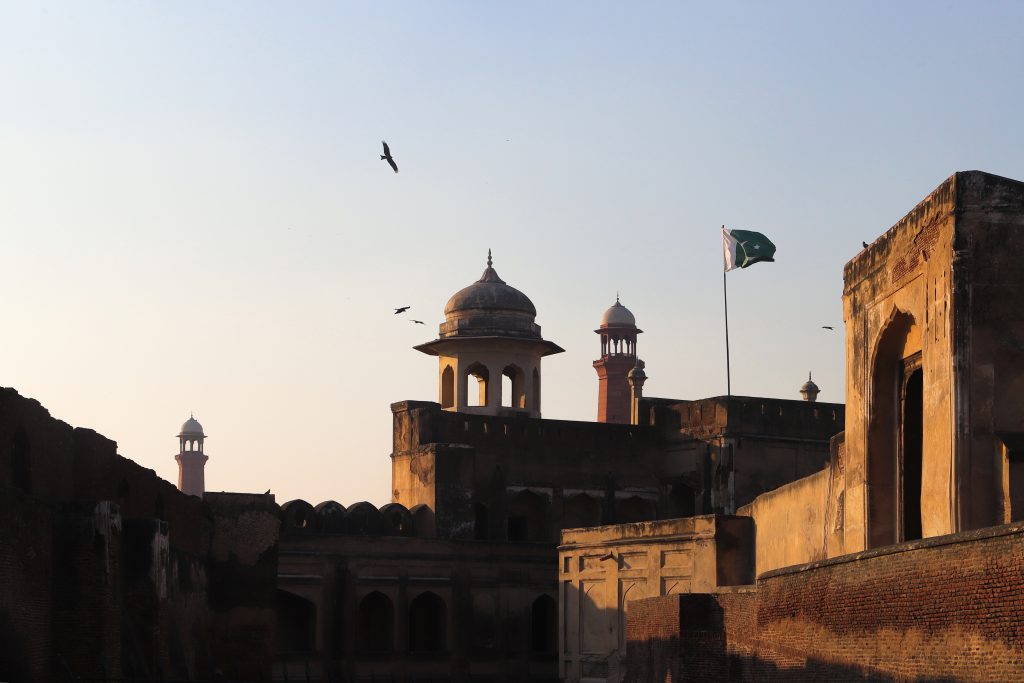Lahore Fort
Constructed by the sixth Mughal Emperor during the 17th century, the Summer Palace was built as a seasonal retreat for the Royal family. Located at the basement of the Shish Mahal of the Lahore Fort, the Summer Palace is a space in which interiors and exteriors blur, where night and day seemingly meld together. This character lends itself to suggestions of rendezvous and intrigue in present-day folklore. For the purposes of the Lahore Biennale 01, the unique architectural features of this site present noteworthy curatorial possibilities. A concern with interiority characterizes many works exhibited in the Summer Palace. Shirin Neshat and Rehana Mangi’s works comment on the experience of women’s life in the region. Historically, public silence has been a feature of female lives in this part of the world. This is powerfully addressed in Neshat’s video where a man sings beautiful renditions of a poem by Jalaluddin Rumi, but when the woman sings her voice does not align with the movements of her lips and she sings in an unintelligible language. Trained as a miniaturist, Rehana Mangi brings her meticulous precision to her textile work but alters this by introducing human hair as an integral feature of the artwork. Hair symbolizes desire, and also a marker of shame in the public presence of female bodily experience. Shahpour Pouyan and Sadia Salim engage with diverse elements and motifs from Indo-Persian court paintings. The conscious erasure of figurative forms in Pouyan’s paintings questions commonly accepted narratives of history. In Sadia Salim’s work, the geometrical pattern in Islamic architecture is miniaturized and rendered as ligree in translucent porcelain. In Hamra Abbas’ work, images that are part of collective memory are re-examined through color separation, in order to “deconstruct the act of seeing.” Nadia Kaabi-Linke’s sound work creates an aural register that captures present day anxieties. Twitching limbs and restless legs are surely a marker of our accelerated era as we are affected by the various stresses of modern day life. Meticulous record-keeping, classification and observation across time is evident in the works of Naiza Khan, and Fazal Rizvi. Each artist works through the legacy of colonialism in the region, noting its impact on geography, ecology, terrain, flora and fauna of the region, during, and after British rule. Huma Mulji records small exchanges that often go unnoticed against the backdrop of an increasingly urbanized society; in her work we are made privy to small gestures shared between the artist and a local bread seller in Lahore since 2010. Amar Kanwar’s video installation is a sensorial undertaking that moves from light into darkness. The film addresses a disintegration of the senses, as well as the nature of collective history. In its slow unfurling, the film comes into dialogue with the photographic work of Firoz Mahmud who turns our focus onto yet another kind of blindness. Bangladeshi textile workers wear extraordinary optical devices fashioned from the textile machinery itself. Here, rather than served by constant labor, the machine is now used to create seeing devices. The workers temporarily attempt to assume the role of viewer, versus that of the one being subjugated. Referencing the labyrinthine nature of the basement structure that has a sophisticated hydraulic system, Iftikhar Dadi & Elizabeth Dadi’s neon work evokes a space situated in endless temporality, in which time assumes a fluid character—and also the Ravi river that once flowed in close proximity. Verses from the poetry of Muhammad Iqbal that reference a “two-silken twine” suggest here the red and blue neon paths as manifestations of the cycle of night and day, tangled in one another as they beckon us to reflect on our relation to deeper history.
Artists
Amar Kanwar
Asad Raza
Faiza Butt
Fazal Rizvi
Firoz Mahmud
Hamra Abbas
Huma Mulji
Iftikhar Dadi & Elizabeth Dadi
Imran Qureshi
Nadia Kaabi-Linke
Naiza Khan
Rehana Mangi
Sadia Salim
Shahpour Pouyan
Shahzia Sikander
Shirin Neshat
Walled City Authority, Lahore

